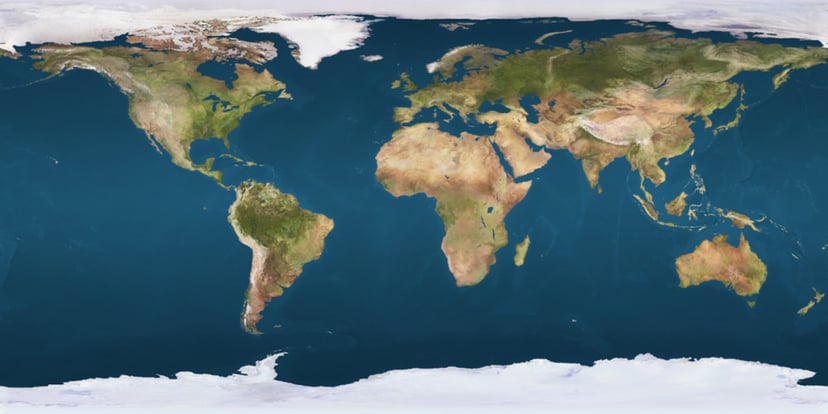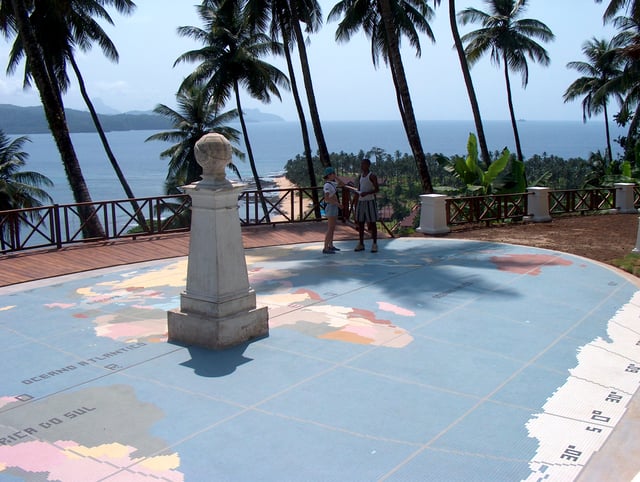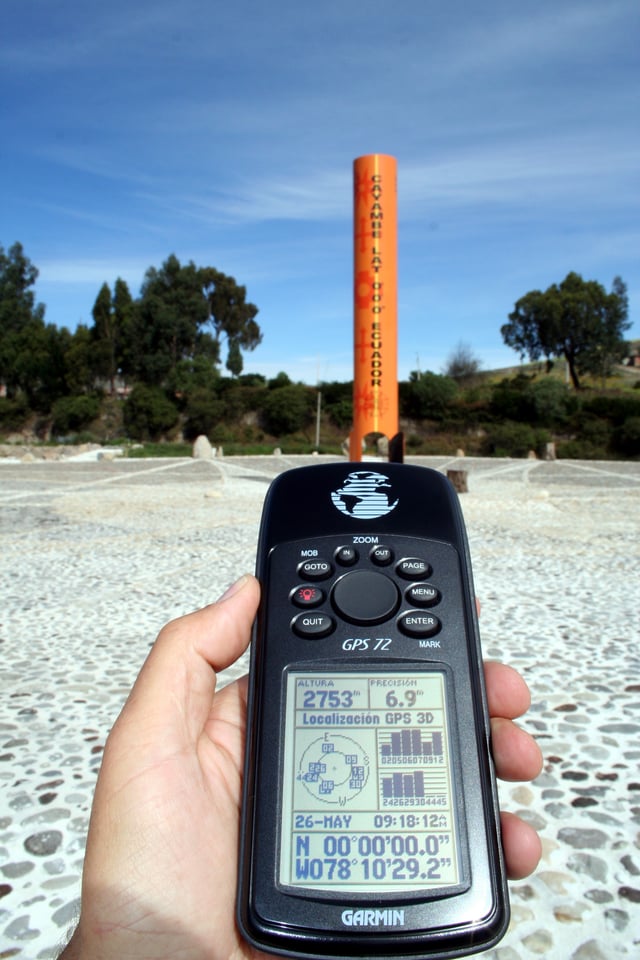Equator

Equator


Nations or territories that touch the Equator (red) or the IERS Reference Meridian (blue)
The equator of a rotating spheroid (such as a planet) is the parallel (circle of latitude) at which latitude is defined to be 0°. It is the imaginary line on the spheroid, equidistant from its poles, dividing it into northern and southern hemispheres. In other words, it is the intersection of the spheroid with the plane perpendicular to its axis of rotation and midway between its geographical poles.
On Earth, the Equator is about 40,075 km (24,901 mi) long, of which 78.8% lies across water and 21.3% over land. Indonesia is the country straddling the greatest length of the equatorial line across both land and sea.
Etymology
The name is derived from medieval Latin word aequator, in the phrase circulus aequator diei et noctis, meaning ‘circle equalizing day and night’, from the Latin word aequare meaning ‘make equal’.[1]
Overview

The Equator marked as it crosses Ilhéu das Rolas, in São Tomé and Príncipe

The Marco Zero monument marking the Equator in Macapá, Brazil
The latitude of the Earth's equator is, by definition, 0° (zero degrees) of arc. The Equator is one of the five notable circles of latitude on Earth; the other four are both polar circles (the Arctic Circle and the Antarctic Circle) and both tropical circles (the Tropic of Cancer and the Tropic of Capricorn). The Equator is the only line of latitude which is also a great circle—that is, one whose plane passes through the center of the globe. The plane of Earth's equator, when projected outwards to the celestial sphere, defines the celestial equator.
In the cycle of Earth's seasons, the equatorial plane runs through the Sun twice per year: on the equinoxes in March and September. To a person on Earth, the Sun appears to travel above the Equator (or along the celestial equator) at these times. Light rays from the Sun's center are perpendicular to Earth's surface at the point of solar noon on the Equator.
Locations on the Equator experience the shortest sunrises and sunsets because the Sun's daily path is nearly perpendicular to the horizon for most of the year. The length of daylight (sunrise to sunset) is almost constant throughout the year; it is about 14 minutes longer than nighttime due to atmospheric refraction and the fact that sunrise begins (or sunset ends) as the upper limb, not the center, of the Sun's disk contacts the horizon.
Earth bulges slightly at the Equator; the "average" diameter of Earth is 12,750 km (7,920 mi), but the diameter at the Equator is about 43 km (27 mi) greater than at the poles.[2]
Sites near the Equator, such as the Guiana Space Centre in Kourou, French Guiana, are good locations for spaceports as they have a fastest rotational speed of any latitude, 460 m/s. The added velocity reduces the fuel needed to launch spacecraft eastward (in the direction of Earth's rotation) to orbit, while simultaneously avoiding costly maneuvers to flatten inclination during missions such as the Apollo moon landings.[3]
Geodesy
Precise location
The precise location of the Equator is not truly fixed; the true equatorial plane is perpendicular to the Earth's spin axis, which drifts about 9 metres (30 ft) during a year. This effect must be accounted for in detailed geophysical measurements.
Exact length
The International Association of Geodesy (IAG) and the International Astronomical Union (IAU) have chosen to use an equatorial radius of 6,378.1366 kilometres (3,963.1903 mi) (codified as the IAU 2009 value).[4] This equatorial radius is also in the 2003 and 2010 IERS Conventions.[5] It is also the equatorial radius used for the IERS 2003 ellipsoid. If it were really circular, the length of the Equator would then be exactly 2π times the radius, namely 40,075.0142 kilometres (24,901.4594 mi). The GRS 80 (Geodetic Reference System 1980) as approved and adopted by the IUGG at its Canberra, Australia meeting of 1979 has an equatorial radius of 6,378.137 kilometres (3,963.191 mi). The WGS 84 (World Geodetic System 1984) which is a standard for use in cartography, geodesy, and satellite navigation including GPS, also has an equatorial radius of 6,378.137 kilometres (3,963.191 mi). For both GRS 80 and WGS 84, this results in a length for the Equator of 40,075.0167 km (24,901.4609 mi).
The geographical mile is defined as one arc-minute of the Equator, so it has different values depending on which radius is assumed. For example, by WSG-84, the distance is 1,855.3248 metres (6,087.024 ft), while by IAU-2000, it is 1,855.3257 metres (6,087.027 ft). This is a difference of less than one millimetre (0.039 in) over the total distance (approximately 1.86 kilometres or 1.16 miles).
The earth is commonly modeled as a sphere flattened 0.336% along its axis. This makes the Equator 0.16% longer than a meridian (a great circle passing through the two poles). The IUGG standard meridian is, to the nearest millimetre, 40,007.862917 kilometres (24,859.733480 mi), one arc-minute of which is 1,852.216 metres (6,076.82 ft), explaining the SI standardization of the nautical mile as 1,852 metres (6,076 ft), more than 3 metres (9.8 ft) less than the geographical mile.
The sea-level surface of the Earth (the geoid) is irregular, so the actual length of the Equator is not so easy to determine. Aviation Week and Space Technology on 9 October 1961 reported that measurements using the Transit IV-A satellite had shown the equatorial diameter from longitude 11° West to 169° East to be 1,000 feet (300 m) greater than its diameter ninety degrees away.
Equatorial countries and territories
The Equator passes through the land of 11 countries. Starting at the Prime Meridian and heading eastwards, the Equator passes through:
| Co-ordinates | Country, territory or sea | Notes |
|---|---|---|
| 0°N 0°E [15] | Atlantic Ocean | Gulf of Guinea, "Null Island" |
| 0°0′N 6°31′E [16] | Passing through Pestana Equador resort on the Ilhéu das Rolas | |
| 0°0′N 9°21′E [17] | Passing 8.9 km (5.5 mi) south of Ayem, 10.6 km (6.6 mi) north of Mayene, Booue | |
| 0°0′N 13°56′E [18] | Passing through the town of Makoua. | |
| 0°0′N 17°46′E [19] | Passing 9 km (5.6 mi) south of central Butembo | |
| 0°0′N 29°43′E [20] | Passing 32 km (20 mi) south of central Kampala | |
| 0°0′N 32°22′E [21] | Lake Victoria | Passing through some islands of |
| 0°0′N 34°0′E [22] | Passing 6 km (3.7 mi) north of central Kisumu | |
| 0°0′N 41°0′E [23] | Passing south of Jamame | |
| 0°0′N 42°53′E [24] | Indian Ocean | Passing between Huvadhu Atoll and Fuvahmulah of the |
| 0°0′N 98°12′E [25] | The Batu Islands, Sumatra and the Lingga Islands | |
| 0°0′N 104°34′E [26] | Karimata Strait | |
| 0°0′N 109°9′E [27] | Borneo (passing through Pontianak) | |
| 0°0′N 117°30′E [28] | Makassar Strait | |
| 0°0′N 119°40′E [29] | Sulawesi (Celebes) | |
| 0°0′N 120°5′E [30] | Gulf of Tomini | |
| 0°0′N 124°0′E [31] | Molucca Sea | |
| 0°0′N 127°24′E [32] | Kayoa and Halmahera islands | |
| 0°0′N 127°53′E [33] | Halmahera Sea | |
| 0°0′N 129°20′E [34] | Gebe and Kawe islands | |
| 0°0′N 129°21′E [35] | Pacific Ocean | Passing between Aranuka and Nonouti atolls, |
| 0°0′N 80°6′W [37] | Passing 24 km (15 mi) north of central Quito, near Mitad del Mundo, and precisely at the location of Catequilla, a pre-Columbian ruin. Also, Isabela Island in the Galápagos Islands | |
| 0°0′N 75°32′W [38] | Passing 4.3 km (2.7 mi) north of the border with Peru | |
| 0°0′N 70°3′W [39] | Amazonas, Roraima, Pará, Amapá (passing slightly south of the city center of the state capital Macapá, and precisely at the Marco Zero monument and the Avenue Equatorial) | |
| 0°0′N 49°21′W [40] | Atlantic Ocean | At the Perigoso Canal (sv) on the mouth of the Amazon River |
Despite its name, no part of Equatorial Guinea lies on the Equator. However, its island of Annobón is 155 km (96 mi) south of the Equator, and the rest of the country lies to the north.
Equatorial seasons and climate

Diagram of the seasons, depicting the situation at the December solstice. Regardless of the time of day (i.e. the Earth’s rotation on its axis), the North Pole will be dark, and the South Pole will be illuminated; see also arctic winter. In addition to the density of incident light, the dissipation of light in the atmosphere is greater when it falls at a shallow angle.
Seasons result from the tilt of the Earth's axis compared to the plane of its revolution around the Sun. Throughout the year the northern and southern hemispheres are alternately turned either toward or away from the sun depending on Earth's position in its orbit. The hemisphere turned toward the sun receives more sunlight and is in summer, while the other hemisphere receives less sun and is in winter (see solstice).
At the equinoxes, the Earth's axis is perpendicular to the sun rather than tilted toward or away, meaning that day and night are both about 12 hours long across the whole of the Earth.
The Equator lies mostly on the three largest oceans: the Atlantic Ocean, the Indian Ocean, and the Pacific Ocean. Near the Equator there is little temperature change throughout the year, though there may be dramatic differences in rainfall and humidity. The terms summer, autumn, winter and spring do not generally apply. Lowlands around the Equator generally have a tropical rainforest climate, also known as an equatorial climate, though cold currents cause some regions to have tropical monsoon climates with a dry season in the middle of the year, and the Somali Current generated by the Asian monsoon due to continental heating via the high Tibetan Plateau causes Greater Somalia to have an arid climate despite its equatorial location.
Average annual temperatures in equatorial lowlands are around 31 °C (88 °F) during the afternoon and 23 °C (73 °F) around sunrise. Rainfall is very high away from cold current upwelling zones, from 2,500 to 3,500 mm (100 to 140 in) per year. There are about 200 rainy days per year and average annual sunshine hours are around 2,000. Despite high year-round sea level temperatures, some higher altitudes such as the Andes and Mount Kilimanjaro have glaciers. The highest point on the Equator is at the elevation of 4,690 metres (15,387 ft), at 0°0′0″N 77°59′31″W [41] , found on the southern slopes of Volcán Cayambe [summit 5,790 metres (18,996 ft)] in Ecuador. This is slightly above the snow line and is the only place on the Equator where snow lies on the ground. At the Equator the snow line is around 1,000 metres (3,300 ft) lower than on Mount Everest and as much as 2,000 metres (6,600 ft) lower than the highest snow line in the world, near the Tropic of Capricorn on Llullaillaco.
Line crossing ceremonies
There is a widespread maritime tradition of holding ceremonies to mark a sailor's first crossing of the Equator. In the past, these ceremonies have been notorious for their brutality, especially in naval practice. Milder line-crossing ceremonies, typically featuring King Neptune, are also held for passengers' entertainment on some civilian ocean liners and cruise ships.
See also
1st parallel north
1st parallel south
Antarctic Circle
Arctic Circle
Coriolis effect
Intertropical Convergence Zone
Prime meridian
Thermal equator
Tropic of Cancer
Tropic of Capricorn
